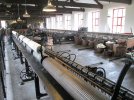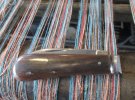- Joined
- Dec 2, 2005
- Messages
- 71,118
Fascinating post Jerry  If I get time later, I'll try and dig out a few loom pics (I'll have to re-size them) and post them here
If I get time later, I'll try and dig out a few loom pics (I'll have to re-size them) and post them here 

The BladeForums.com 2024 Traditional Knife is available! Price is $250 ea (shipped within CONUS).
Order here: https://www.bladeforums.com/help/2024-traditional/

Very interesting discussion on tackler's knives. I never had heard of the term, but a tackler's counterpart in the US would be called a loom fixer. Assigned anywhere from 50 to 100 looms or more, they were responsible for "fixing" looms that had mechanical problems or were producing off quality fabric. Fixers were paid an hourly rate, where weavers were generally paid by the amount of production for their respective loom set, so it was in their interest to keep the looms running at all times.
@smiling-knife The advertisement for Buffalo Pick could be a reference for several items. In shuttle loom terminology a picking or picker stick (made of wood) was a common part to wear out or even break as it was the part that was a key component in the power transfer process . A picker would have been the part attached to a picking stick that actually touches the shuttle nose and propels it between the shed (threads of yard) across the loom raceway. In addition there were picks (comb like metal devices) that were used to pick out defects.
Knives were used to trim the picking sticks to fit pickers. Pickers looked a like hammer heads and the picker stick like a very long handle, pickers were made of wood in the early days and later made of some type of resin reinforced with fabric (I can't recall, it's been thirty five years since I ran my last shuttle loom).
I stumbled across the name in the Case catalog section, on page 82 of Stewart and Ritchie's book, Big Book of Pocket Knives: Identification and Values. I had thought that given the name these were used like the tackler knives in the UK. Both seem to be descendants of the Sheffield patterns as recovered from the Steamship Arabia.
The use of decorative castings on the Smith and Sons machine is surprising to modern eyes. They certainly took pride in their work!I've got a few more pics to post
Jack Black the first photo is a sectional warper, mostly used for stripes or heavier yarns that did not need a lot of preparation to weave. It was used to wrap the yarn on the warp of the loom (the beam at the back).
I actually bought and sold two of those dinosaurs. I found them in Waco Texas where a guy was making saddle blankets for horses.







It is the same with a great deal of old machinery Bart, and not just the British stuff, look at this US-made printing press
Older textile machinery commonly used castings (sand cast) for the main frame parts, the part numbers and manufacturer name along with associated patents were usually included. I last visited a textile foundry in the early 2000's, they had a very large room full of wooden patterns, some had been in use since the 40's or earlier from what I was told. They had (IIRC) broaching machines for gears, huge metal lathes for turning shaft ends to proper diameter, a drop forging set up (I was told but did not see), and a very large specialty surface grinder. It was an intensive operation and no doubt cost a lot of money to set up and operate.
B Bartleby
Interesting to note that the term Luddite derives from a folklore tale involving a person by the name of Ned Ludd smashing up knitting frames in England in the early 19th century. The industrial age was not embraced by all. The same applies to technology of today. Some of us are dragged kicking and screaming into the 21st century
I get accused of being something of a Luddite myself from time to time, although I do like the useful aspects of some technology, I don't pursue it for its own sake.The industrial age was not embraced by all. The same applies to technology of today. Some of us are dragged kicking and screaming into the 21st century
